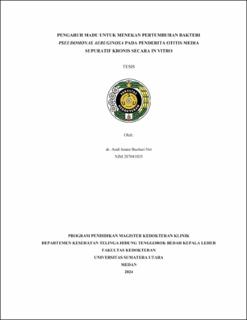Pengaruh Madu Untuk Menekan Pertumbuhan Bakteri Pseudomonas Aeruginosa Pada Penderita Otitis Media Supuratif Kronis (OMSK) Secara In Vitro
The Effect of Honey In Suppressing the Growth of Pseudomonas Aeruginosa Bacteria In Patients with Chronic Suppurative Otitis Media (CSOM) In Vitro

Date
2024Author
Nasution, Andi Imam Buchari
Advisor(s)
Zahara, Devira
Asroel, Harry Agustaf
Metadata
Show full item recordAbstract
Background: CSOM caused by pathogenic bacteria, particularly Pseudomonas aeruginosa and Staphylococcus aureus, which can lead to serious complications if left untreated. Honey is known for its natural antibacterial properties and is considered a potential alternative therapeutic agent.
Purpose: This study aims to explore whether honey, known for its antimicrobial properties, can suppress the growth of these bacteria.
Method: The study used an in vitro experimental design with the disc diffusion methods. Specimens were collected intraoperatively from middle ear secretions of patients diagnosed with CSOM at Adam Malik hospital and the ATCC bacteria. Honey were extracted into five different concentrations: 60%, 70%, 80%, 90% and 100%, and compared with a positive control (ofloxacin 5 mcg) and negative control (NaCl).
Result: The results demonstrated there was no significant antibacterial activity in P. aeruginosa clinical bacteria. The honey exhibited a significant antibacterial activity against P. aeruginosa ATCC 27852 and S. aureus ATCC 29213. The inhibition zones measured showed that honey, particularly at higher concentrations (notably 80%), effectively suppressed bacterial growth in ATCC bacteria. The mean inhibition zone for S. aureus ATCC 29213 at 80% honey concentration was 12.00 mm, compared to the positive control group with a mean inhibition zone of 30.94 mm. These findings indicate a consistent antibacterial effect of honey across tested concentrations.
Conclusion: Honey extract shows no antibacterial effect on clinical P. aeruginosa in CSOM patient, but there was antibacterial activity against P. aeruginosa ATCC 27852 and S. aureus ATCC 29213.
